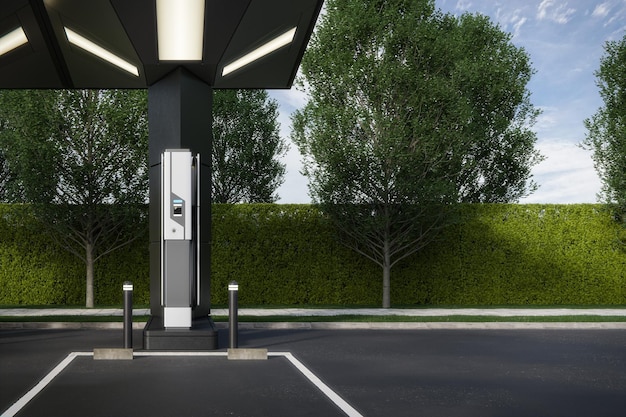Decoding the Impact of $7.5B EV Charging Investment on the US Auto Industry

The Infrastructure Bill’s $7.5 billion investment in electric vehicle (EV) charging stations aims to accelerate EV adoption in the US, impacting automakers by increasing demand for EVs, requiring strategic shifts in production, and fostering innovation in battery technology and charging infrastructure.
The automotive landscape in the United States is undergoing a significant transformation, largely fueled by the increasing adoption of electric vehicles (EVs). A key catalyst in this shift is the Infrastructure Investment and Jobs Act, particularly its allocation of $7.5 billion towards building a national network of EV charging stations. Let’s delve into decoding the impact of the Infrastructure Bill’s $7.5 billion investment in electric vehicle charging stations on the US auto industry.
Understanding the Infrastructure Bill’s EV Charging Initiative
The Infrastructure Investment and Jobs Act, signed into law, represents a monumental commitment to modernizing America’s infrastructure. A significant portion of this investment is dedicated to accelerating the transition to electric vehicles by addressing a critical barrier: the lack of accessible and reliable charging infrastructure. This initiative aims to deploy a network of 500,000 EV chargers across the country, making EV ownership more practical and appealing to a wider range of consumers.
The Goals of the Investment
The primary objectives of this investment extend beyond simply increasing the number of charging stations. It seeks to:
- Reduce range anxiety: By strategically placing charging stations along major highways and in urban areas, the initiative aims to alleviate concerns about the limited range of EVs and the availability of charging options.
- Promote equitable access: The plan prioritizes investments in underserved and rural communities, ensuring that the benefits of EV adoption are accessible to all Americans, regardless of their location or socioeconomic status.
- Stimulate economic growth: The development and deployment of EV charging infrastructure are expected to create jobs in manufacturing, installation, and maintenance, contributing to economic growth and innovation.
Furthermore, the initiative sets standards for interoperability and reliability, ensuring that all charging stations are compatible with different EV models and that they operate consistently. This standardization is crucial for building consumer confidence and fostering a seamless charging experience.

In conclusion, the Infrastructure Bill’s EV charging initiative is a multifaceted effort designed to overcome the barriers to EV adoption, promote equitable access to clean transportation, and stimulate economic growth. Its success hinges on strategic planning, effective implementation, and collaboration among government, industry, and communities.
Impact on US Automakers: A Shift in Strategy
The $7.5 billion investment in EV charging infrastructure is poised to significantly impact US automakers, compelling them to adapt their strategies to meet the evolving demands of the electric vehicle market. This shift necessitates a focus on production, innovation, and collaboration to remain competitive in the rapidly changing automotive landscape.
Increased EV Production
With a robust charging infrastructure in place, automakers are incentivized to ramp up their production of electric vehicles. This requires substantial investments in manufacturing facilities, supply chain management, and workforce training to meet the anticipated surge in demand.
Furthermore, automakers must diversify their EV offerings to cater to a wide range of consumer preferences, from compact cars to SUVs and trucks. This diversification demands flexibility in manufacturing processes and the ability to quickly adapt to changing market trends.
Investing in Battery Technology
The heart of any electric vehicle is its battery, and advancements in battery technology are crucial for improving the range, performance, and affordability of EVs. US automakers are increasingly investing in research and development to enhance battery energy density, reduce charging times, and extend battery lifespan.
Moreover, securing a reliable supply of battery materials, such as lithium, nickel, and cobalt, is essential for ensuring the long-term viability of EV production. Automakers are exploring partnerships with mining companies and battery manufacturers to establish a secure and sustainable supply chain.
Collaboration and Partnerships
The transition to electric vehicles requires collaboration among automakers, technology companies, charging infrastructure providers, and government agencies. By pooling resources and expertise, these stakeholders can accelerate the development and deployment of EV technologies and infrastructure.
- Joint ventures: Automakers are forming joint ventures with battery manufacturers and charging network operators to streamline the production and distribution of EVs.
- Industry standards: Collaboration on industry standards for charging connectors, communication protocols, and safety regulations is essential for ensuring interoperability and consumer confidence.
- Government incentives: Automakers are working with government agencies to advocate for policies that support EV adoption, such as tax credits, rebates, and infrastructure investments.

In summary, the $7.5 billion investment in EV charging infrastructure presents both challenges and opportunities for US automakers. By adapting their strategies to focus on increased EV production, investments in battery technology, and collaboration with key stakeholders, automakers can thrive in the evolving electric vehicle market.
Consumer Adoption and Market Expansion
The expansion of EV charging infrastructure is intrinsically linked to consumer adoption and the overall growth of the electric vehicle market. A comprehensive and reliable charging network addresses key barriers to EV ownership, making electric vehicles a more attractive option for a broader segment of the population.
Addressing Range Anxiety
One of the primary concerns among potential EV buyers is “range anxiety,” the fear of running out of battery power before reaching a charging station. The deployment of 500,000 EV chargers across the country aims to alleviate this anxiety by providing convenient and accessible charging options for drivers.
Increased Convenience and Accessibility
Beyond addressing range anxiety, the initiative seeks to make EV charging as convenient and accessible as refueling a gasoline-powered vehicle. This involves strategically locating charging stations in high-traffic areas, such as shopping centers, workplaces, and highway rest stops.
Furthermore, the plan prioritizes investments in underserved communities, ensuring that EV charging is available to all Americans, regardless of their location or socioeconomic status.
Positive Impact on Resale Value
As the EV market matures and charging infrastructure expands, the resale value of electric vehicles is expected to increase. This is because a robust charging network makes older EVs more practical and appealing to potential buyers, boosting their value in the used car market.
In conclusion, the expansion of EV charging infrastructure is a critical factor in driving consumer adoption and market expansion. By addressing range anxiety, increasing convenience and accessibility, and boosting resale values, the initiative aims to make electric vehicles a mainstream transportation option for Americans.
The Role of Government and Policy
Government policies and regulations play a pivotal role in shaping the electric vehicle market and ensuring the effective deployment of charging infrastructure. These policies can incentivize EV adoption, promote standardization, and foster collaboration among industry stakeholders.
Incentives and Subsidies
Government incentives, such as tax credits and rebates, can significantly reduce the upfront cost of purchasing an electric vehicle, making them more affordable for consumers. These incentives can be targeted towards specific income groups or geographic regions to promote equitable access to clean transportation.
Furthermore, subsidies for the installation of EV charging stations can encourage businesses and property owners to invest in charging infrastructure, accelerating the deployment of charging networks.
Safety and Reliability Standards
Establishing clear standards for the safety and reliability of EV charging stations is essential for building consumer confidence and ensuring a consistent charging experience. These standards should address issues such as electrical safety, cybersecurity, and data privacy.
Supporting Domestic Manufacturing
Government policies can support the growth of the domestic EV industry by promoting the manufacturing of electric vehicles and battery components within the United States. This can create jobs, reduce reliance on foreign supply chains, and foster innovation in EV technologies.
- Tax breaks: Providing tax breaks for companies that manufacture EVs and battery components in the US.
- R&D funding: Investing in research and development to advance EV technologies and reduce production costs.
- Workforce training: Supporting workforce training programs to equip workers with the skills needed to manufacture and maintain electric vehicles and charging infrastructure.
In summary, government policies and regulations are essential for fostering a thriving electric vehicle market and ensuring the effective deployment of charging infrastructure. By providing incentives, establishing standards, and supporting domestic manufacturing, governments can accelerate the transition to clean transportation and create a more sustainable future.
Challenges and Obstacles
Despite the significant investments and policy support, the deployment of EV charging infrastructure faces several challenges and obstacles that must be addressed to ensure its success. These challenges range from technical issues to regulatory hurdles and public acceptance.
Grid Capacity and Upgrades
The widespread adoption of electric vehicles will place significant demands on the electrical grid, potentially requiring upgrades to transmission and distribution infrastructure. Ensuring that the grid can handle the increased load is crucial for preventing blackouts and maintaining a reliable supply of electricity.
There are also potential implications for rural electricity providers who may need infrastructural upgrades to support EV charging stations in more remote areas.
Standardization and Interoperability
The lack of standardization in charging connectors and communication protocols can create confusion for EV drivers and limit the interoperability of charging stations. Establishing industry-wide standards is essential for ensuring that all EVs can use any charging station, regardless of the manufacturer.
In conclusion, overcoming these challenges and obstacles requires collaboration among government, industry, and communities. By addressing technical issues, streamlining permitting processes and adapting to the unique needs of the area and consumer base, the deployment of EV charging infrastructure can be accelerated, paving the way for a cleaner and more sustainable transportation future.
Overcoming obstacles requires a focus on education and creating consumer confidence in the emerging EV landscape.
The Future of EV Charging and Automotive Innovation
The future of EV charging is intertwined with automotive innovation, paving the way for more efficient, convenient, and sustainable transportation options. As technology advances and consumer demand grows, the EV charging landscape is poised to undergo significant transformations.
Wireless Charging
One of the most promising innovations in EV charging is wireless charging, which eliminates the need for cables and connectors. Wireless charging pads can be installed in parking spaces or even embedded in roadways, allowing EVs to charge automatically while parked or driving.
Fast Charging Technologies
The development of ultra-fast charging technologies is crucial for reducing charging times and making EVs more convenient for long-distance travel. These technologies require high-power charging stations and advanced battery management systems, but they can significantly reduce the time it takes to fully charge an EV.
Vehicle-to-Grid (V2G) Technology
Vehicle-to-grid (V2G) technology enables electric vehicles to not only draw power from the grid but also send power back to the grid. This can help stabilize the grid, reduce peak demand, and provide backup power during outages.
- Smart grid applications: V2G technology can be integrated with smart grids to optimize energy distribution and reduce reliance on fossil fuels.
- Energy storage: Electric vehicles can serve as mobile energy storage units, providing backup power for homes and businesses.
- Cost savings: EV owners can earn revenue by selling excess energy back to the grid.
| Key Point | Brief Description |
|---|---|
| ⚡ Infrastructure Bill | $7.5B investment in EV charging stations. |
| 📈 EV Production | Automakers increase production to meet demand. |
| 🔋 Battery Tech | Investments in better range, charge times. |
| 🤝 Collaboration | Partnerships for streamlined EV production. |
Frequently Asked Questions
▼
The Infrastructure Bill allocates $7.5 billion to expand the EV charging network, aiming for 500,000 chargers nationwide and reducing range anxiety for potential EV buyers.
▼
US automakers are compelled to increase EV production, invest in advanced battery technology, and form strategic collaborations to meet rising demand and stay competitive.
▼
Consumers benefit from reduced range anxiety, increased convenience with more charging locations, and potentially higher resale values for their electric vehicles.
▼
Government provides incentives like tax credits and subsidies, sets safety standards, and supports domestic manufacturing to foster a thriving EV market and infrastructure.
▼
Challenges include electrical grid capacity, standardization of charging connectors, streamlining permitting processes, and adapting to consumer needs and unique location.
Conclusion
The Infrastructure Bill’s $7.5 billion investment in EV charging stations represents a pivotal moment for the US auto industry. By addressing critical barriers to EV adoption, this initiative has the potential to transform the automotive landscape, drive innovation, and create a more sustainable transportation future. As automakers, policymakers, and consumers work together to overcome challenges and embrace new technologies, the electric vehicle market is poised for continued growth and success.





